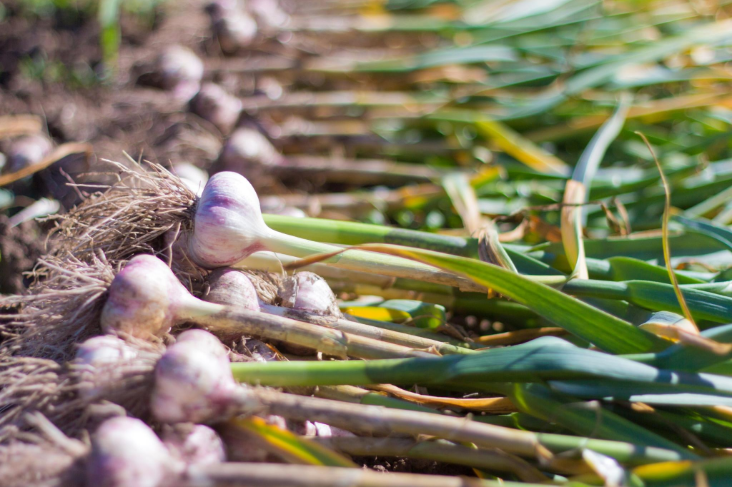How to Plant, Grow, and Harvest Garlic – Hefei Dielegance Biotechnology Co., Ltd.

Garlic is a pungent, nutrient-packed powerhouse that’s vital in countless recipes. It’s best planted in the fall in most areas.
About Garlic
Garlic is surprisingly easy to grow, as long as you get the timing right. In addition to having an intense flavor and many culinary uses, the “stinking rose” also serves as an insect repellent in the garden, and it has been used as a home remedy for centuries.
Planting
Garlic does best in full sun, so select a planting site that receives 6 to 8 hours of sunlight per day.
A week or so before planting, prepare the soil by mixing in a healthy helping of compost or aged manure. Then, immediately before planting, work a couple tablespoons of 5-10-10 complete fertilizer, bonemeal, or fish meal into the soil several inches below where the base of the garlic cloves will rest.
Raised beds should be 2 to 3 feet wide and at least 10 to 12 inches deep.

When to Plant Garlic
Garlic is most often planted in the fall (between late September and November) and harvested in the following summer (between June and August). In areas that get a hard frost, plant garlic cloves 6 to 8 weeks before the first fall frost date, before the ground freezes.
Garlic does best if it can experience a “dormancy” period of colder weather—at least 40˚F (4°C)—that lasts 4 to 8 weeks. By planting garlic bulbs in the fall, they have time to develop healthy roots before temperatures drop and/or the ground freezes, but not enough time for the garlic to form top growth. Then, by early spring, the bulbs “wake up” from their dormancy and start rapidly producing foliage, followed by bulbs, before the harshest heat of summer stops their growth.
In mild climates, you can plant garlic cloves as late as February or March, but the resulting bulbs won’t be as large. However, you can still enjoy the garlic scapes during the summer. (Scapes are the plant’s tender green shoots and have a mild garlic flavor. Enjoy on eggs, in salads, as a pizza topping, or in stir-fries!) If you plant in the spring, wait to do so until after the soil can be worked and it crumbles apart easily.
How to Plant Garlic
- Select large, healthy cloves, free of disease. The larger the clove, the bigger and healthier the bulb you will get the following summer.
- Break apart cloves from the bulb a few days before planting, but keep the papery husk on each individual clove.
- Plant cloves 4 to 8 inches apart and 2 inches deep, in their upright position (with the wider root side facing down and pointed end facing up).
- Plant in rows spaced 6 to 12 inches apart. A single 10-foot row should yield about 5 pounds of the fragrant bulbs, depending on the variety.

How to Grow Garlic
- Farmers in areas where the ground freezes should mulch garlic beds heavily with straw or leaves to ensure proper overwintering.
- Mulch should be removed in the spring after the threat of frost has passed. (Young shoots can’t survive in temps below 20°F / -6°C on their own.
- In the spring, as warmer temperatures arrive, shoots will emerge through the ground.
- Cut off any flower shoots that emerge in spring. These may decrease bulb size.
- Garlic is a heavy feeder. In early spring, side-dress with or broadcast blood meal, pelleted chicken manure, or a synthetic source of nitrogen such as a pelleted fertilizer.
- Fertilize again just before the bulbs begin to swell in response to lengthening daylight (usually early May in most regions). Repeat if the foliage begins to yellow.
- Keep the planting site well weeded. Garlic doesn’t do well with competition—it needs all available nutrients!
- Water every 3 to 5 days during bulbing (mid-May through June). If May and June are very dry, irrigate to a depth of 2 feet every eight to 10 days. As mid-June approaches, taper off watering.

Garlic Harvesting
- Harvest from fall plantings will range from late June to August. If you planted in the spring, calculate your approximate harvest date based on the “days to maturity” of the garlic variety you planted.
- In general, the clue is to look for yellowing foliage, but this isn’t the case for all garlic varieties. Harvest when the tops just begin to yellow and fall over, but before they are completely dry.
- Before digging up your whole crop, it’s a good idea to sample one bulb. Lift a bulb to see if the crop is ready. We often dig up a bulb before the tops are completely yellow (in late June or early July) as some garlic types will be ready earlier. The garlic head will be divided into plump cloves and the skin covering the outside of the bulbs will be thick, dry and papery.
- If pulled too early, the bulb wrapping will be thin and easily disintegrate.
- If left in the ground too long, the bulbs sometimes split apart. The skin may also split, which exposes the bulbs to disease and will affect their longevity in storage.
- To harvest, carefully dig (don’t pull or yank stems by hand) up the bulbs using a garden fork. Avoid damaging the roots and especially the root-plate (where they attach to the bulb). Lift the plants and carefully brush off surplus soil, but do not remove any foliage or roots before putting them to dry thoroughly.